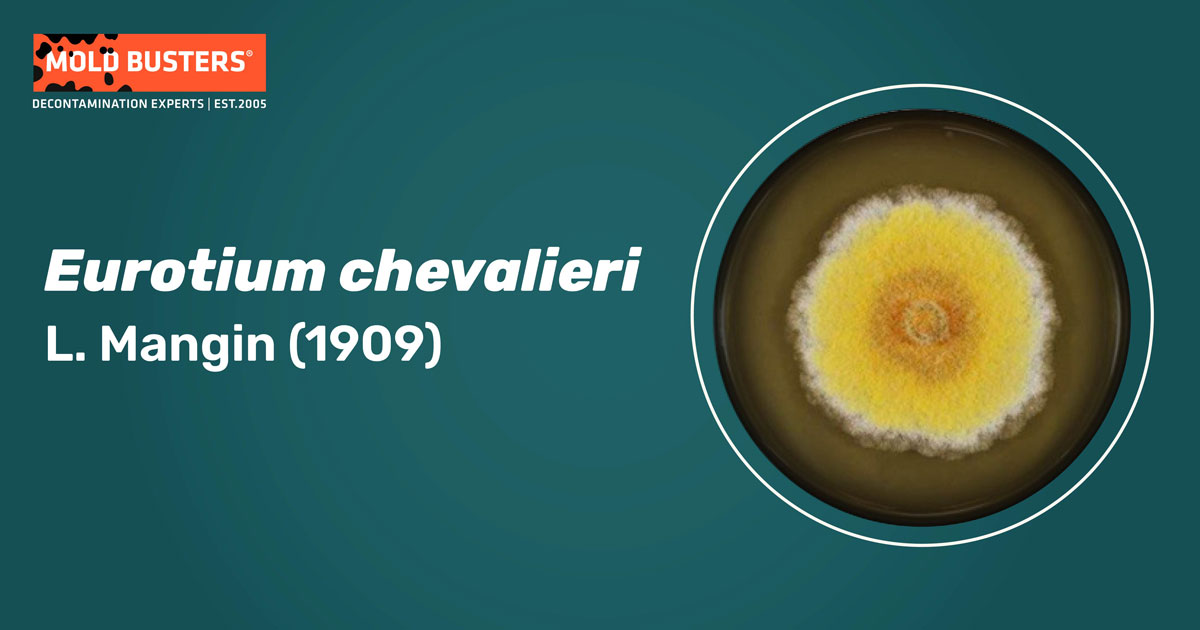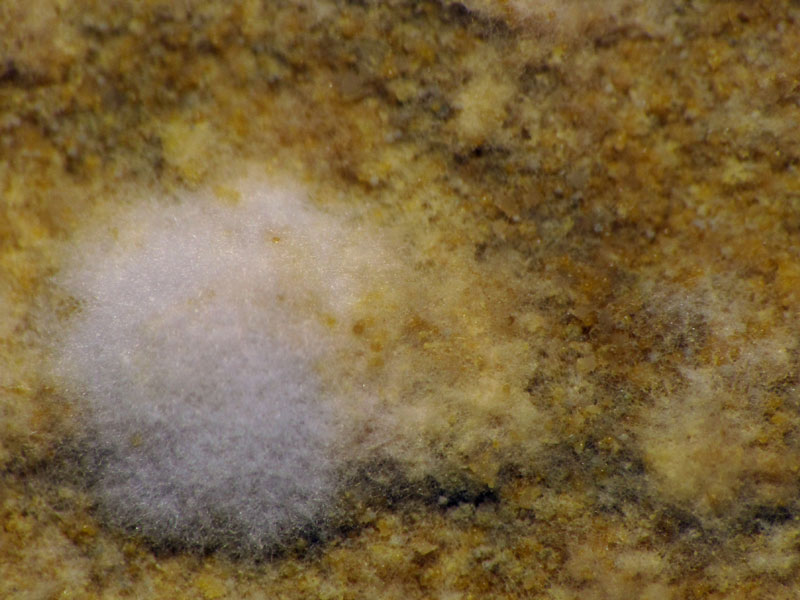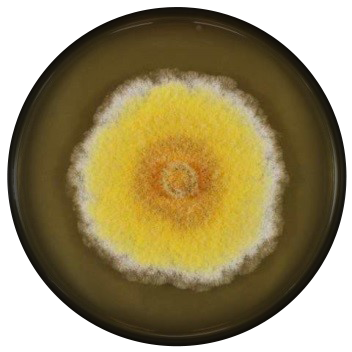L. Mangin (1909)
What is Eurotium chevalieri?
Eurotium chevalieri is the sexual state of the species Aspergillus chevalieri [1] that belongs to the division Ascomycota. Genus Aspergillus is an example in mycology where dual naming applies [2, 3]. It contains five subgenera that produce species with both asexual (reproduce by cloning and fragmentation) and sexual (reproduce by spores) states [2, 4].

Eurotium species are xerophytic, which means that they grow in environments with low availability of water, and this way can cause spoilage of dry or concentrated materials [2]. The main morphological characteristic of the Eurotium species is forming a bright yellow fruit body known as cleistothecia [2, 5].
Where can Eurotium chevalieri be found?
Like other aspergilli, Eurotium chevalieri is a ubiquitous soil-borne fungus [6]. It can be found in building materials, dust, leather, softwood, and textiles [5]. Since modern heating systems remove moisture from buildings, xerophytic molds are among the dominant portion of indoor fungal communities. It can be readily found in museums, libraries, and homes on the floor, carpet, and mattress dust [5, 6, 7]. E. chevalieri is also associated with dried seeds and milled foodstuffs [6]. Being able to grow on stored cereals, grain, dry, and preserved foods with high sugar content, Eurotium species are known as spoiling fungi, causing significant economic losses in food commodities [8].

How does Eurotium chevalieri look like?
Colonies of E. chevalieri grown on Potato Dextrose Agar (PDA) reach 7 cm (2.76 inches) in diameter after ten days at a temperature of 30 °C (86 °F) [1]. They are grey in the central areas [1], with abundant, bright yellow cleistothecia, typical for Eurotium species [2]. Cleistothecia can be seen on the medium as a continuous yellow layer (Fig. 1) [1]. Every ascus in cleistothecia consists of eight lens-shaped ascospores, approximately 4.5×3.4 µm in diameter [2].
E. chevalieri and most species closely related to it grow on Czapek Yeast Agar (CYA), or Malt Yeast Extract Agar (MYA) supplemented with 20% sucrose (CY20S and M60Y) [8]. The growth ability on these media at 37 °C (45 °F) is a reliable characteristic for distinguishing morphologically similar species within the Aspergillus (Eurotium) genus [8].

after one week of incubation at 20°C (68 °F)
(Image source: Japan Collection of Microorganisms)
Eurotium chevalieri and food spoilage
E. chevalieri is one of the most common Eurotium species that is usually associated with changes in the nutritional quality and sensory properties of raw materials and processed food items, affecting shelf-life and leading to secondary metabolites [8].
Secondary metabolites are compounds produced by fungi that are not essential for their growth and reproduction but can play an important role in their survival in nature. Some of them are significant for human health, positively (antibiotics) or negatively (mycotoxins). Although some of its metabolites, such as echinulin or sterigmatocystin, are considered hazardous [11, 12], E. chevalieri is not associated with the production of mycotoxins.
Fungi such as E. chevalieri can change macroconditions favorable for the growth of mycotoxin-producing filamentous fungi [8, 10]. The growth of xerophytic fungi, including E. chevalieri, causes the release of metabolic water, increasing moisture content in contaminated material [10]. This enables the growth of mesophilic species (with higher water requirement), which can be toxic to humans (Alternaria spp., Penicillium spp., and Fusarium spp.) [10]. Along with Eurotium rubrum, E. repens, and E. amstelodami, E. chevalieri is a common spoilage factor for dehydrated food items such as flour, pasta, bakery products, cereals, spices, nuts, dried fruit, and meat [13]. This fungal species is also isolated from cheese [12], chocolate products [14], medicinal herbs [15], and animal feed [8, 11].
What are effects of Eurotium chevalieri on human health?
Eurotium chevalieri is reported as one of the most common mold species in indoor environments, composing up to 88% of the fungal spore profile isolated from house dust of Japanese homes [7]. However, there are very few reports referring to its effect on human health. E. chevalieri is considered a rare opportunistic pathogen. Its pathogenicity was reported for the first time in 1994 when three cases of cutaneous (skin) aspergillosis were described [16]. In all reported cases, the infection followed previous skin trauma [16]. E. chevalieri has also been isolated in clinical cases of aspergillosis such as cerebral, respiratory, eye, sinus, and ear infections [17].
How to treat Eurotium chevalieri infections?
There is little published data on antifungal susceptibility of members of the section Aspergillus (Eurotium). According to the reports, E. chevalieri is sensitive to antifungal drugs such as posaconazole, anidulafungin, micafungin, amphotericin B, itraconazole, oxiconazole, anirofine, and voriconazole [16, 17].

Did you know?
Offices in Canada are the most affected by the Basidiospores mold group?! Find out more exciting mold stats and facts on our mold statistics page.
References
- Kanokmedhakul et al. (2011). Bioactive meroterpenoids and alkaloids from the fungus Eurotium chevalieri. Tetrahedron. 67: 5461-5468
- Samson, A. & Pitt, I. J. (2007). Nomenclatural considerations in naming species of Aspergillus and its teleomorphs. Studies in Mycology. 59: 67-70.
- Eurotium. Retreived from bustmold.com
- Hocking, A. D. and Pitt, I. J. (1997). Fungi and Food Spoilage. Springer, Boston, Ma. Chapter: Aspergillus and related teleomorphs. pp 339-416
- Visagie, C. M. et al. (207). A survey of xerophilic Aspergillus from indoor environment, including descriptions of two new section Aspergillus species producing eurotium-like sexual states. MycoKeys 19: 1-30
- Samson, R. A: et al. (2001). Common and important species of fungi and actinomycetes in indoor environment. Microorganisms in home and indoor work environments, diversity, health impacts, investigation and control. Tailor and Francis, London. Chapter 5. pp:431-432.
- Fukutomi et al. (2015). Senzitization to fungal allergens: resoved and unresolved issues. Allergology international. 64: 321-331
- Greco, M. et al. (2016). Effect of water activity and temperature on the growth of Eurotiumspecies isolated from animal feeds. Revista Ibroamericana de Micologia. 35 (1): 39-48
- Chen, A. J. et al. (2017). Polyphasic taxonomy of Aspergillus section Aspergillus (formerly Eurotium), and its occurrence in indoor environments and food. Studies in Mycology. 88: 37–135
- Greco, M. et al. (2015).Taxonomic Characterization and Secondary Metabolite Profiling of Aspergillus Section Aspergillus Contaminating Feeds and Feedstuffs. 7: 3512-3537
- Ali et al. (1989). Toxicity of echinulin from Aspergillus chevalieri in rabbits. Toxicology letters, 48: 235-241
- Dobson, A.D.W. (2017) Cheese: Chemistry, Physics and Microbiology, 4th Edition: General Aspects-Volume 1. USA: Eds. P.L.H. McSweeney, P.F. Fox, P. Cotter, DW Everett. Chapter: Mycotoxins in Cheese. pp 595-601.
- Hocking, A. D. (1999). Problems Caused by Fungi. Encyclopedia of Food Microbiology. Second edition. Volume 1. Academic Press Elsevier. pp: 471-481.
- Bensoussan, M. et al. (1997).Growth characteristics of Aspergillus chevalieri and other fungi from undercoating of chocolate truffles. Advances In Solid State fermentation. Springer Science+Business Media Dordrecht. pp 39-47.
- Chen, L. et al. (2020). Occurrence and Characterization of Fungi and Mycotoxins in Contaminated Medicinal Herbs. Toxins. 12 (30): 11-14
- Naidu, J & Singh, S. M. (1994). Aspergillus chevalieri (Mangin) Thorn and Church: a new opportunistic pathogen of human cutaneous aspergillosis. Mycoses. 37: 271-274
- Salah, H. et. al. (2019). The Emergence of Rare Clinical Aspergillus Species in Qatar:
Molecular Characterization and Antifungal Susceptibility Profiles. Frontiers in Microbiology. 10: 1-1

Get Special Gift: Industry-Standard Mold Removal Guidelines
Download the industry-standard guidelines that Mold Busters use in their own mold removal services, including news, tips and special offers:

Written by:
Jelena Somborski
Mycologist
Mold Busters
Edited by:
Dusan Sadikovic
Mycologist – MSc, PhD
Mold Busters
